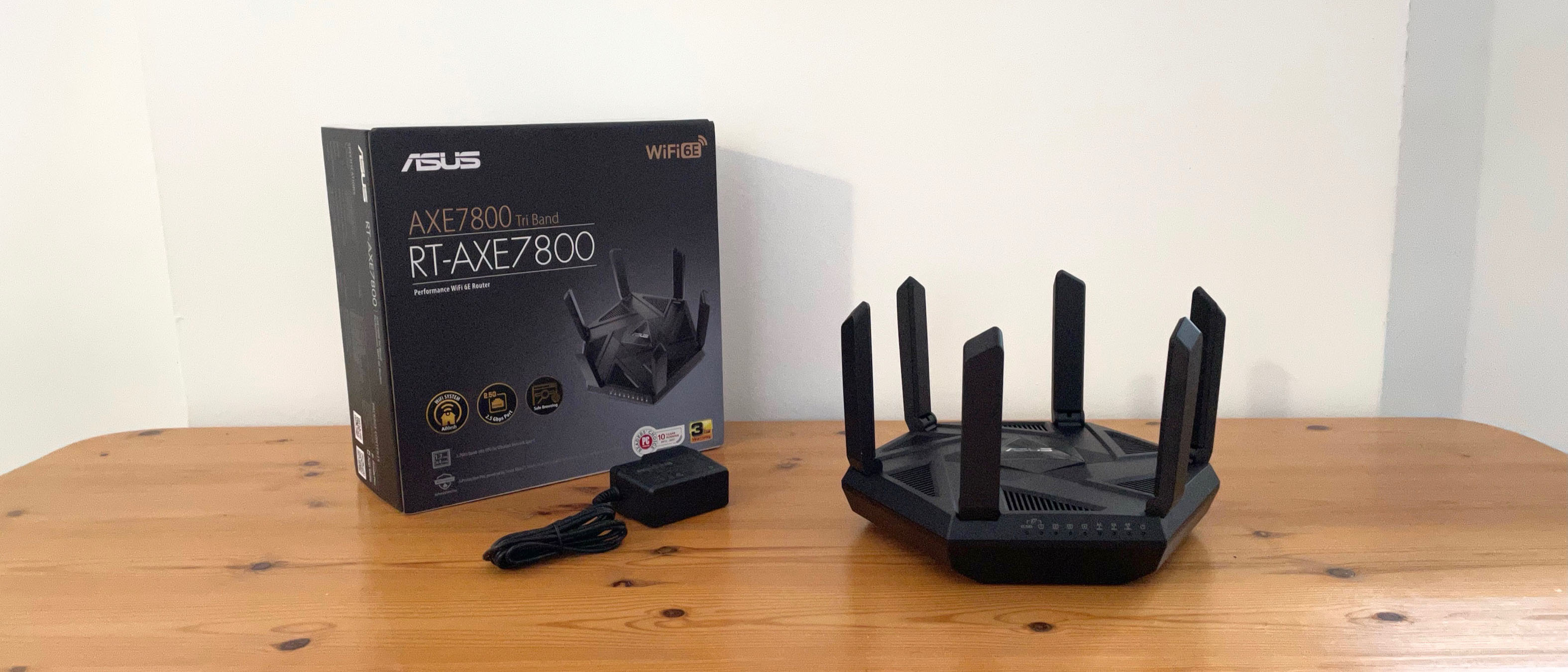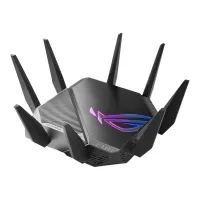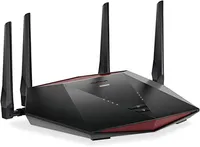TechRadar Verdict
The Asus RT-AXE7800 provides the latest Wi-Fi 6E technology with impressive speeds for both Wi-Fi and wired connections - and does so at a very competitive price. And while the Asus app could provide a bit more help for beginners, it works well and provides good parental controls and other features.
Pros
- +
Good value
- +
7.8Gbps Wi-Fi 6E performance
- +
Good parental controls
Cons
- -
Complete overkill for most home users
- -
Could provide more help for beginners
Why you can trust TechRadar
Asus RT-AXE7800: Two-minute review
Routers that use the latest Wi-Fi 6E technology are still pretty expensive - as we saw with Asus’ top-of-the-range Rapture RT-AXE11000 just recently. However, the Rapture routers are aimed at hard-core gamers who need super-fast response times, so the company has also released a more affordable option in the somewhat unusual, hexagonal shape of its new RT-AXE7800.
The Asus RT-AXE7800 doesn’t carry the Rapture brand name, so it’s not specifically aimed at gamers looking for the best gaming router. However, it still provides tri-band Wi-Fi 6E with a top speed of 7.8Gbps, which is more than fast enough for most home broadband connections.
It also includes high-end wired connections, with a 2.5 Gigabit Ethernet port designed for use with high-speed fibre broadband services. Features like that will provide all the speed and performance needed for streaming music, 4K video and even some serious gaming action too. However, the RT-AXE7800 is still competitively priced, making it a great upgrade option.
If you’re planning to buy a new laptop or iPad that supports Wi-Fi 6E, then the Asus RT-AXE7800 may be the best router for you.
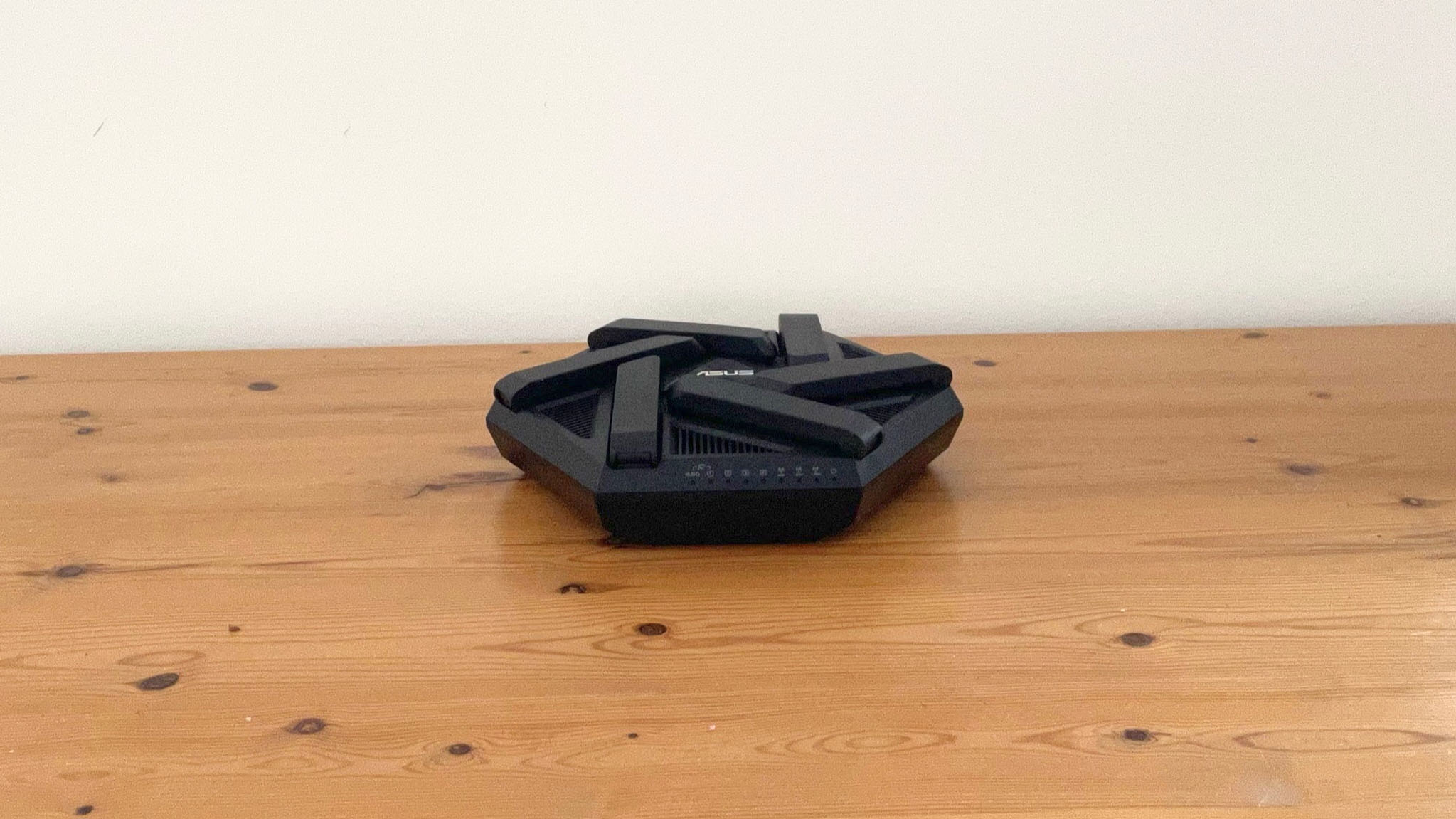
The Asus RT-AXE7800 catches your eye straight out of the box, with an unusual hexagonal design and a series of external antennae that are initially folded down into a striking rosette pattern. It’s not just for show, though, as the six antennae fold upwards in order to provide good transmission for your new Wi-Fi network.
As mentioned, the RT-AXE7800 supports tri-band Wi-Fi 6, broadcasting on the new 6.0GHz frequency band, as well as the more conventional 2.4GHz and 5.0GHz bands used by older Wi-Fi 5 and Wi-Fi 6 routers.
Tucked around the back of the router you’ll find a total of five Ethernet ports. Two of these ports can double up as either WAN ports for your Internet connection or LAN ports for connecting a laptop or other devices that work best with lag-free wired connections. One of these ports supports high-speed Internet connections of up to 2.5Gbps, while the second provides more standard Gigabit Ethernet.
Sign up for breaking news, reviews, opinion, top tech deals, and more.
However, the router also includes three Gigabit Ethernet LAN ports as well, and you can ‘aggregate’ - or combine - two of the Gigabit ports to provide a 2 Gigabit wired connection if required. There’s also a USB-A (3.0) port, which can be used to connect a USB hard drive or other storage device to your network.

Getting the router set up is fairly straightforward when using the Asus Router app for iOS or Android - although it does help if you already understand the basics of Wi-Fi networking. When you first plug it in, the RT-AXE7800 creates a default network, which you can join simply by scanning the QR code printed on the base of the router.
This default network is unprotected, though, so it’s important to quickly proceed to the next step and create a new network with proper password protection. This is where things get a little more complicated, though.
The apps provided with many routers keep things simple by offering to automatically create a single network that merges the different frequency bands, but may also provide additional options for more advanced users who want greater control over their network. In contrast, the Asus Router app prefers to keep the new 6.0GHz frequency separate at all times, so you only have two options here - you can create three separate networks on the 2.4GHz, 5.0GHz and 6.0GHz bands (ach with its own name and password), or create two networks, with 6.0GHz remaining separate while the 2.4GHz and 5.0GHz bands are merged.
Seeing all that info thrown onto the screen of your smartphone might be a little daunting for newcomers who don’t know very much about networking. Asus’ skimpy Quickstart guide doesn’t provide much help either, so the Asus Router app could be a little more user-friendly for beginners.
The app does provide some useful features, though. You can monitor the traffic on your network in real-time, and there’s a QoS option - quality of service - that allows you to prioritise specific applications, such as streaming video or gaming, to make sure they get the best performance possible.
The app also provides some useful parental controls, including the ability to create a schedule for your children’s Internet access, as well as content filters that can block unsuitable material online. And, unlike most of Asus’ rivals, it doesn’t require an additional monthly subscription for these parental controls. It does offer additional security features, provided by Trend Micro, which cost $89.95 per year (approx. £73.77 or AU$134.00), but at least it doesn’t get carried away with the hard-sell here, and the Asus Router app provides all the main features you need without any annoying hidden charges.
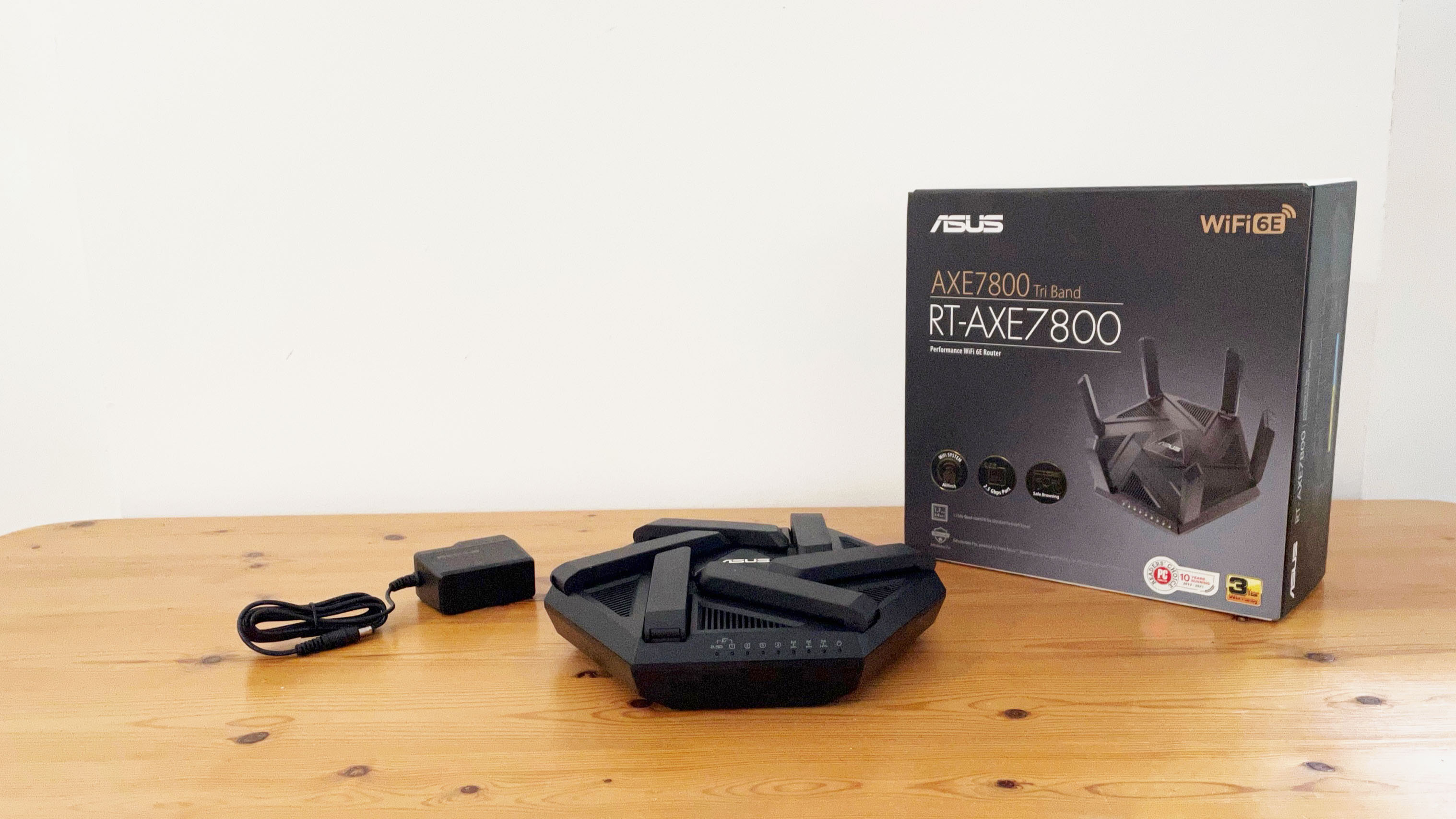
And, as you’d expect from a state-of-the-art Wi-Fi 6E router, the Asus RT-AXE7800 provides impressive performance. Devices that are located in the same room as our old Wi-Fi 5 router can achieve speeds of 150Mbps on the Ookla speedtest, and 19MB/s for Steam downloads. Those are the best speeds supported by our office broadband, and with the RT-AXE7800 connected to our old router it didn’t make any real difference for devices in that same room.
However, we also have an office at the back of the building that our old router can’t reach, which forces us to use a set of PowerLine adaptors to provide wired connections in that office. That’s where the RT-AXE7800 made a difference, as it was easily able to extend its high-speed Wi-Fi into the back office, maintaining our top speeds of 100Mbps and 19MB/s for the Ookla and Steam tests with no trouble at all.
It’s worth noting, though, that those speeds were achieved using the 2.4GHz and 5.0GHz bands only. We haven’t yet been able to find a laptop that supports Wi-Fi 6E during testing in order to test the new 6.0GHz band properly, so the jury is still out on the performance of Wi-Fi 6E.
But, if you’re lucky enough to have a brand new laptop or mobile device that does support Wi-Fi 6E, then the RT-AXE7800 provides an impressive Wi-Fi upgrade at a competitive price.
Asus RT-AXE7800: Price & availability
- How much does it cost? $329.99 / £249.99 (about AU$485)
- When is it available? Available now
- Where can you get it? Available in the US, UK, and Australia
The blazing 11Gbps speed of the Rapture RT-AXE1100 cost a pretty penny, weighing in at around $550, but the Asus RT-AXE7800 is a much more affordable proposition, costing $329.99 / £249.99 (about AU$485) while still offering seriously fast Wi-Fi running at 7.8Gbps.
That’s a really good price for such a fast router - especially one that supports the latest Wi-Fi 6E technology. The RT-AXE7800 is available directly from Asus and other online retailers in the US and UK. It’s also been announced as a new product on Asus’ website in Australia, but hasn’t yet gone on sale, and the price has yet to be confirmed.
- Value: 5 / 5
Asus RT-AXE7800: Specs
| Wi-Fi: | Tri-band Wi-Fi 6E (2.4GHz/5.0GHz/6.0GHz) |
| Wi-Fi Speed: | 7.8Gbps |
| Connectivity: | 1x 2.5 Gigabit Ethernet (WAN/LAN), 1x Gigabit Ethernet (WAN/LAN), 3x Gigabit Ethernet (LAN), 1x USB-A (3.0) |
| Processor: | 1.7GHz quad-core |
| Memory: | 512MB |
| Storage: | 256MB Flash |
| Dimensions (with antennae): | 210 x 210 x 150mm, 1.03kg |
Should you buy the Asus RT-AXE7800?
| Value | Wi-Fi 6E is state-of-the-art for Wi-Fi technology right now, and the RT-AXE7800 provides strong performance at a competitive price. | 5 / 5 |
| Design | Asus’ app could be a little more user-friendly for beginners, but the RT-AXE7800 is neatly designed and packed with powerful hardware and useful software features. | 5 / 5 |
| Performance | With its new 6.0GHz band and 7.8Gbps speed, the RT-AXE7800 is an affordable and future-proof router upgrade that will last for years. | 5 / 5 |
| Average rating | Beginners might find the app a little unhelpful, but the RT-AXE7800 gets all the basics right, providing the latest high-speed Wi-Fi and wired connections at a competitive price. | 5 / 5 |
Buy it if...
You’re a gadget fiend
Wi-Fi 6E is the current state-of-the art for Wi-Fi technology, but it’s already available in new devices such as the latest iPads from Apple. So a Wi-Fi 6E router is the ideal upgrade for people who like to keep up with the latest tech.
You’re forward-thinking
Despite its high speed and Wi-Fi 6E tech, the Asus RT-AXE7800 is very competitively priced, so it’s a good investment if you want to future-proof your home network.
You’re a power user
As well as its impressive Wi-Fi performance the RT-AXE7800 also provides high-speed wired connectivity too, with 2.5 Gigabit Ethernet for your broadband connection, and the ability to ‘aggregate’ two 1 Gigabit Ethernet ports for a gaming rig that might need a high-speed wired connection.
Don't buy it if...
You’re on a budget
The Asus RT-AXE7800 is competitively priced, but few of us really need a state-of-the-art router that supports Wi-Fi 6E. There are many less expensive Wi-Fi 6 routers that will do the job for most domestic broadband services.
You’re a network newbie
The Asus Router app works well and has several useful features. However, it doesn’t provide much help for beginners, so it might be a bit daunting for network newbies.
You don’t have fibre
The RT-AXE7800 provides a 2.5 Gigabit Ethernet port for high-speed fibre broadband as well as ‘port aggregation’ for wired connections. Most home broadband services simply aren’t fast enough to take advantage of those options.
Asus RT-AXE7800: Also consider
| Row 0 - Cell 0 | Asus RT-AXE7800 | Asus Rapture RT-AXE11000 | Netgear Nighthawk XR1000 |
| Price: | $329.99 / £249.99 (about AU$485) | $549.99 / £479.99 | $369.99 / £349.99 / $529 |
| Wi-Fi: | Tri-band Wi-Fi 6E (2.4GHz/5.0GHz/6.0GHz) | Tri-band Wi-Fi 6E (2.4GHz/5.0GHz/6.0GHz) | Wi-Fi 6 (IEEE 802.11ax), dual-band 2.4GHz and 5.0GHz + 5.0GHz |
| Wi-Fi Speed: | 7.8Gbps | 11.0Gbps | Row 3 - Cell 3 |
| Connectivity: | 1x 2.5 Gigabit Ethernet (WAN/LAN), 1x Gigabit Ethernet (WAN/LAN), 3x Gigabit Ethernet (LAN), 1x USB-A (3.0) | 1x 2.5 Gigabit Ethernet (WAN/LAN), 1x Gigabit Ethernet (WAN), 4x Gigabit Ethernet (LAN), 2x USB 3.2 | WAN = 1x Gigabit Ethernet; LAN = 4x Gigabit Ethernet; 1x USB 3.0 |
| Processor: | 1.7GHz quad-core | 1.8GHz quad-core | 1.5GHz tri-core |
| Memory: | 512MB | 1GB | 512MB |
| Storage: | 256MB Flash | 256GB Flash | 256MB Flash |
| Dimensions (with antennae): | 210 x 210 x 150mm, 1.03kg | 175 x 300 x 300mm | 295 x 200 x 64mm |
Asus Rapture RT-AXE11000
It’s seriously expensive, but this is as good as Wi-Fi currently gets. Aimed at hard-core gamers, the Rapture provides Wi-Fi 6E with an insane top speed of 11Gbps.
Read our full Asus Rapture RT-AXE11000 review
Netgear Nighthawk XR1000
If you don’t need state-of-the-art Wi-Fi 6E then Netgear’s Nighthawk gaming router provides strong Wi-Fi 6 performance, with a speed of 5.4Gbps, and additional features for gamers.
Read our full Netgear Nighthawk XR1000 review
How we tested the Asus RT-AXE7800
We pride ourselves on our independence and our rigorous review-testing process, offering up long-term attention to the products we review and making sure our reviews are updated and maintained - regardless of when a device was released, if you can still buy it, it's on our radar.
First reviewed January 2023
Cliff Joseph is a former Editor of MacUser magazine, and a freelance technology writer with 30 year’s experience in the industry (and old enough to remember when Apple was close to going bust…).
His first job involved using Macs for magazine sub-editing and typesetting, which led to the realisation that these computer-thingies might actually turn out to be useful after all. After a few years specialising in the Mac side of the market, he went freelance and embraced the wide world of digital technology, including Windows PCs, digital audio and hi-fi, and networking. Somewhere along the line he also developed a bit of a gaming habit and has stubbornly waved the flag for Mac gaming for far too many years.
